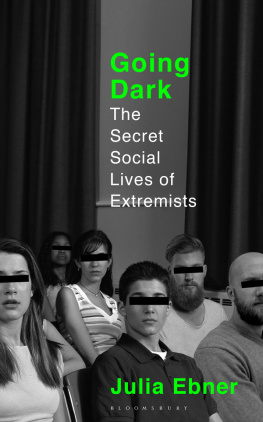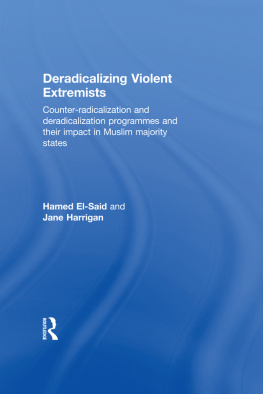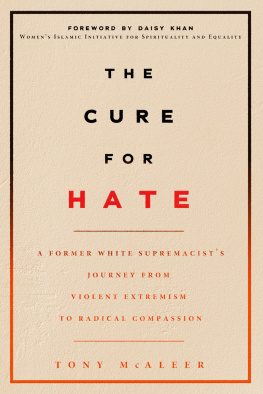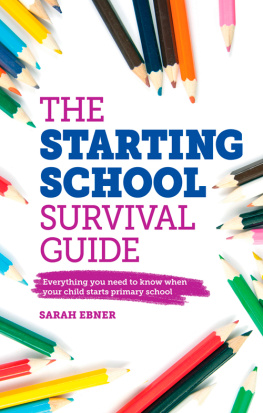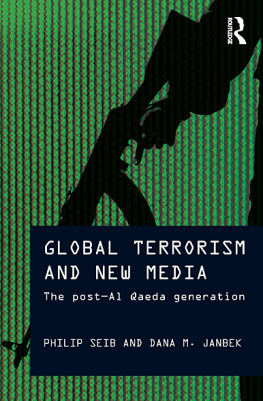
GOING DARK
BLOOMSBURY PUBLISHING
Bloomsbury Publishing Plc
50 Bedford Square, London, WC1B 3DP, UK
BLOOMSBURY, BLOOMSBURY PUBLISHING and the Diana logo are trademarks of Bloomsbury Publishing Plc
First published in Great Britain 2020
Copyright Julia Ebner, 2020
Julia Ebner has asserted her right under the Copyright, Designs and Patents Act, 1988, to be identified as Author of this work
All rights reserved. No part of this publication may be reproduced or transmitted in any form or by any means, electronic or mechanical, including photocopying, recording, or any information storage or retrieval system, without prior permission in writing from the publishers
Bloomsbury Publishing Plc does not have any control over, or responsibility for, any third-party websites referred to or in this book. All internet addresses given in this book were correct at the time of going to press. The author and publisher regret any inconvenience caused if addresses have changed or sites have ceased to exist, but can accept no responsibility for any such changes
A catalogue record for this book is available from the British Library
ISBN: HB: 978-1-5266-1678-4; TPB: 978-1-5266-1677-7; eBook: 978-1-5266-1676-0
Typeset by Newgen KnowledgeWorks Pvt., Ltd, Chennai, India
To find out more about our authors and books visit www.bloomsbury.com and sign up for our newsletters
ALSO BY JULIA EBNER
The Rage: The Vicious Circle of Islamist and
Far-Right Extremism
To my parents
Contents
When I was seven years old, I wanted to study tornadoes. A storm chaser! was my standard reply to the adults who bothered asking a first-grader what she wanted to become when she grew up. I had seen the movie Twister and was fascinated by the speed, force and unpredictability of storms. To fully understand tornadoes and create warning systems, my Twister heroes concluded, you needed to get to the centre of a storm.
Instead of chasing storms I have ended up chasing extremists for a living. In many ways this isnt too dissimilar. Like storms, extremist movements are fast, have strong destructive potential and can change direction at any time. In my day job at the London-based Institute for Strategic Dialogue (ISD), I monitor extremist movements across the UK, Europe and the US. My team works with cutting-edge technology partners and universities such as MIT to track and analyse harmful online content ranging from extremist propaganda to pieces of disinformation. Based on this research, I advise governments, security forces, tech firms and activists on how to respond to extremist activities. There is no set recipe for this; sometimes we have to readjust our strategy on a daily basis to match the quick changes in the tactics of extremists. Beyond that, the problem is far too complex to focus on one stakeholder only. One day, I might brief a national intelligence unit about the cryptocurrency transactions of neo-Nazis, the next I could be advising Facebook on how to improve its take-downs of white nationalist materials. In the morning, I might find myself in a meeting with European policymakers to discuss the future of regulating the online space, in the evening at a radicalisation-prevention workshop in a high school in Saxony.
But even with all these different layers of engagement, my day job comfortably keeps me within the bubbles of those in charge of upholding the status quo rather than those attacking it. At the end of the day, the counter-extremism space offers only a feline view of the cat-and-mouse game between those who try to disrupt and destabilise our democracies and those who seek to protect them. To comprehend what is causing the havoc around us, I realised, one needs to be inside, where the engines of the movements can be observed and studied. How do the extreme fringes mobilise supporters and lure vulnerable individuals into their networks? What are their visions of the future and how do they plan to reach them? What are the social dynamics that keep members inside a group and how are they evolving?
To find answers I have spent two years undercover, adopting five different identities and joining a dozen tech-savvy extremist groups across the ideological spectrum from jihadists and Christian fundamentalists to white nationalists, conspiracy theorists and radical misogynists. During my working hours I was the cat, but in my spare time I joined the mice.
This personal research has taken me to some bizarre, at times dangerous places, both online and offline. I have watched extremist movements coordinate terrorist attacks, launch disinformation operations and plot intimidation campaigns. I was in the channels where the alt-right planned the lethal Charlottesville rally, ISIS plotted cyberattacks on American infrastructure, German trolls coordinated online attacks on politicians and Italian neo-fascists carried out information operations to influence the 2018 election. From participating in a secret strategy meeting hosted by white nationalists in an Airbnb in south London to joining a militant neo-Nazi rock festival on the GermanPolish border and receiving hacking instructions from ISIS jihadists, my time inside these movements not only taught me about extremists strategies and tactics, it also exposed me to their human dimensions as well as to my own vulnerabilities.
The extent of the abhorrent content I came across during this project was sobering, and the number of young people involved saddening. On the surface, the movements I joined have little in common. But I would come to learn that on the inside they all operate similarly: their leaders create protected social bubbles to encourage antisocial behaviour in the wider world. Their members globalise anti-globalist ideologies and use modern technologies to put into practice anti-modern visions.
Going Dark exposes the hidden roots of life within extremist movements. Each part deals with a different stage in the radicalisation process. Recruitment dives into the vetting procedures of an American neo-Nazi group, and the European white nationalist Generation Identity (GI) movement. Socialisation explores the brainwashing hotbeds for Trad Wives and jihadi brides from within. Communication uncovers the far rights media warfare strategies from the inside of hate storms and trolling armies. In Networking I reveal how extremists create international hubs, using social networks and even dating apps, which lay the foundation for their growing global networks. Mobilisation is a journey that starts in the chat rooms of the organisers behind the Charlottesville rally and ends at Europes biggest neo-Nazi rock festival in Ostritz. In Attack, I receive hacking instructions from leading ISIS and neo-Nazi hackers before diving into the sub-cultures that radicalised the man behind the deadly attack in New Zealand in March 2019. And finally, Is the Future Dark? reflects on the scale and nature of the extremism challenge that faces all of us, predicts its evolution over the next decades and features ten courageous initiatives with the potential to inspire a new generation of global agents of change.
The interplay between technology and society has long been key to radical change. In 1936, the German Jewish philosopher Walter Benjamin argued that the rise of fascism was propelled by inventions such as screen printing and early photocopying technologies, which changed the public perception of media, arts and politics. The birth of technologically progressive yet socially regressive movements shaped the power dynamics of twentieth-century Europe.
Next page
